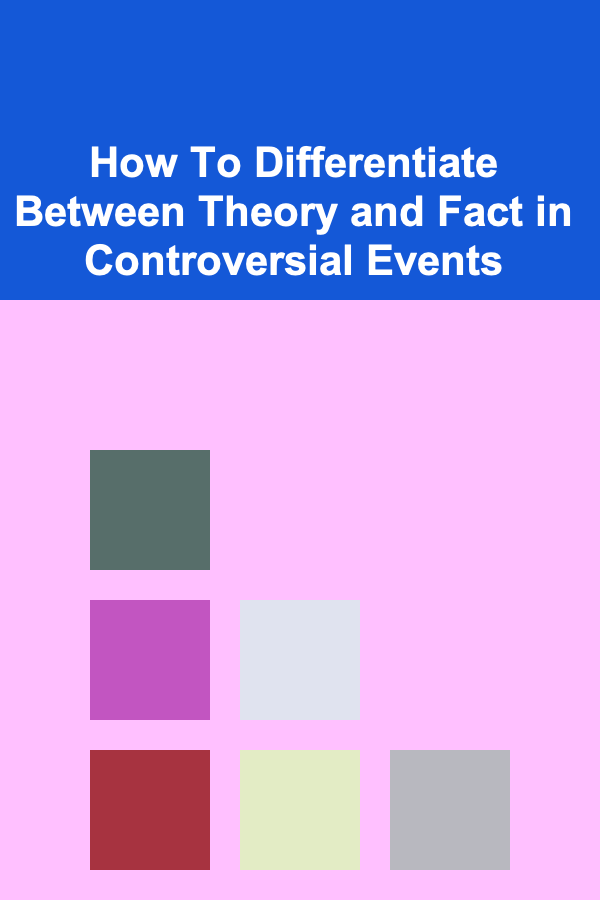
How To Differentiate Between Theory and Fact in Controversial Events
ebook include PDF & Audio bundle (Micro Guide)
$12.99$10.99
Limited Time Offer! Order within the next:

Controversial events, whether they are political, social, or historical in nature, often evoke strong opinions and emotions. These events, whether recent or ancient, typically come with a cloud of misinformation, speculation, and confusion. In such situations, it is important to differentiate between theory and fact to form a more accurate and objective understanding of the issue at hand.
In this article, we will explore how to distinguish between theory and fact when analyzing controversial events. We will look at how facts are defined, how theories emerge, and the processes involved in scrutinizing and verifying information. Moreover, we will examine the psychological, social, and technological factors that influence how people interpret and present facts and theories, and how you can adopt effective methods to evaluate sources, claims, and narratives critically.
Understanding Facts and Theories
Before diving into methods for differentiating between facts and theories, let's first establish what each term means, particularly in the context of controversial events.
What is a Fact?
A fact is an objective reality that can be proven true or false based on evidence. Facts are verifiable pieces of information that remain consistent, regardless of individual interpretation or belief. They are based on concrete data, direct observations, or events that have occurred. For example, it is a fact that the Earth orbits the Sun, or that a specific historical event occurred on a specific date.
In controversial events, facts tend to be the hardest to pin down. They can be obscured by bias, interpretation, or a lack of complete information. However, facts can often be verified through empirical evidence, reliable sources, and scientific or journalistic inquiry.
What is a Theory?
A theory, on the other hand, is an explanation or a set of ideas that attempt to account for a certain phenomenon, event, or set of facts. Theories are based on conjecture, interpretation, and analysis, and are often used to explain aspects of controversial events that may not be fully understood or observable. Theories may be plausible, but they are not proven facts. They are open to debate, revision, or rejection as new information arises.
For example, in controversial events, there may be competing theories about why a particular incident occurred, who was responsible, or what its long-term effects might be. A theory may be built on available facts but could involve assumptions, hypotheses, and speculative reasoning.
The Role of Bias in Controversial Events
When analyzing controversial events, both facts and theories can be influenced by bias. Bias can distort perception, leading individuals to focus on specific aspects of an event while ignoring others. This is where critical thinking and discernment become crucial.
Confirmation Bias
Confirmation bias is the tendency to seek out and prioritize information that supports existing beliefs while disregarding information that contradicts them. In controversial events, people often gravitate toward theories that align with their preconceptions, even if those theories are not grounded in facts. This can create echo chambers where misinformation spreads unchecked.
Political and Ideological Bias
Controversial events often have a political or ideological dimension, and the interpretation of facts can be colored by these perspectives. People may have a vested interest in promoting a particular narrative or theory, whether to support their political beliefs or to defend certain interests. This kind of bias is especially prevalent in media coverage, where outlets may emphasize certain facts while downplaying others.
Strategies for Differentiating Between Theory and Fact
Now that we have established the definitions of facts and theories and explored the role of bias, we can examine specific strategies for distinguishing between the two in the context of controversial events.
1. Seek Multiple Sources of Information
One of the most effective ways to separate fact from theory is by seeking out a wide range of sources. Relying on a single source---whether it be a news outlet, a social media post, or even an expert---can be dangerous because each source may present a selective narrative.
- Primary sources: When possible, consult primary sources of information, such as official documents, direct testimonies, or eyewitness accounts. These sources tend to offer more reliable data than secondary sources, which may be more prone to interpretation or bias.
- Credible and diverse sources: Rely on reputable news outlets, academic publications, and expert analyses that offer multiple viewpoints on the issue. While each source may have its own biases, collectively they can provide a more balanced view.
2. Evaluate the Evidence
A critical step in discerning between theory and fact is evaluating the quality and verifiability of the evidence presented. Facts are supported by direct, tangible evidence, such as photographs, videos, official records, or scientific data. Theories, however, may rely more heavily on inference, conjecture, or unverified sources.
- Check for verification: Look for independent verification of claims, especially when it comes to photographs, videos, or eyewitness accounts. In the digital age, it is easy for misinformation to spread rapidly through altered images or manipulated videos.
- Assess the quality of evidence: High-quality evidence is often consistent, reliable, and consistent with other corroborating facts. Weak evidence, on the other hand, may be ambiguous, uncorroborated, or circumstantial.
3. Differentiate Between Interpretation and Fact
In many controversial events, the facts themselves are not in dispute, but the interpretation of those facts can vary widely. Different individuals or groups may present the same set of facts but offer different explanations or theories about what those facts mean.
- Interpretations of events: Examine whether claims being made are interpretations or actual facts. For example, two people might witness the same event and describe it differently, with each offering a personal interpretation or opinion on what caused it.
- Contextualize the facts: Look at the broader context in which facts are presented. A fact in isolation can be misleading if it is not placed within the proper context. Theories often arise when people attempt to make sense of facts by explaining their significance or causes.
4. Watch Out for Conspiracy Theories
Conspiracy theories are often presented as alternative explanations of controversial events that contradict widely accepted facts. These theories can be particularly appealing because they offer simple, emotionally satisfying explanations for complex issues. However, most conspiracy theories are based on faulty reasoning, cherry-picked evidence, or deliberate misinformation.
To avoid falling into the trap of conspiracy thinking, it is important to:
- Question extraordinary claims: Conspiracy theories often make extraordinary claims about hidden agendas, cover-ups, or nefarious actors. While it is essential to question authority and investigate questionable events, extraordinary claims require extraordinary evidence.
- Examine the plausibility of the theory: Conspiracy theories often rely on complex webs of speculation that require multiple assumptions to be true. If a theory is overly convoluted or involves a lot of "coincidences" or assumptions, it is likely not grounded in fact.
5. Consider the Expertise of the Sources
Experts and specialists in a particular field are often the best sources for evaluating whether something is a fact or theory. However, it is important to ensure that the experts you consult are truly qualified and have no conflicts of interest. Expertise is a key factor in distinguishing reliable information from hearsay or speculation.
- Qualifications and credentials: Check the credentials of individuals offering expert opinions. An expert in the field relevant to the controversial event (e.g., a historian for historical events, a scientist for scientific claims) is more likely to provide a fact-based analysis.
- Peer review: For academic claims or scientific theories, peer-reviewed journals are often the gold standard of reliability. Peer-reviewed work undergoes scrutiny by other experts in the field, which helps ensure that the findings are valid.
The Psychological and Social Dimensions of Controversy
It is also important to acknowledge the psychological and social dimensions of controversial events, which play a significant role in how facts and theories are perceived and shared.
Cognitive Biases and Heuristics
Humans are prone to various cognitive biases, which can lead us to interpret information in ways that reinforce our beliefs and preferences. Common cognitive biases include:
- Anchoring bias: The tendency to rely too heavily on the first piece of information encountered when making decisions.
- Availability heuristic: The tendency to overestimate the likelihood of events based on their immediate availability in memory, often due to media coverage or personal experience.
These biases can cloud our judgment, making it difficult to evaluate information objectively. Being aware of these biases can help individuals approach controversial events with a more critical mindset.
The Influence of Social Media
Social media has revolutionized the way information spreads, but it also amplifies the spread of misinformation and theories. In the fast-paced, viral nature of online platforms, facts are often twisted, distorted, or misrepresented to fit specific narratives. As a result, it is more important than ever to cross-check sources and remain skeptical of viral content.
Conclusion
Differentiating between theory and fact in controversial events requires careful analysis, critical thinking, and an awareness of biases. By understanding what constitutes a fact, recognizing the role of theories, evaluating evidence, seeking multiple sources, and considering the psychological factors at play, individuals can become more adept at forming objective opinions and navigating complex issues.
While it is often tempting to embrace the simplest explanation or the most emotionally compelling narrative, the truth often lies somewhere in the middle. Being diligent in your analysis and always questioning assumptions will lead to a clearer understanding of controversial events and the facts behind them.

Building Passive Income with Deep Learning Projects
Read More
How to Sell Digital Marketing Services on LinkedIn: An Actionable Guide
Read More
How to Use Dimmer Switches to Control Your Home Lighting
Read More
How To Clean Your Washing Machine
Read More
How to Restore Old Coins Found Metal Detecting
Read More
10 Tips for Optimizing Warehouse Layout as a Logistics Coordinator
Read MoreOther Products

Building Passive Income with Deep Learning Projects
Read More
How to Sell Digital Marketing Services on LinkedIn: An Actionable Guide
Read More
How to Use Dimmer Switches to Control Your Home Lighting
Read More
How To Clean Your Washing Machine
Read More
How to Restore Old Coins Found Metal Detecting
Read More